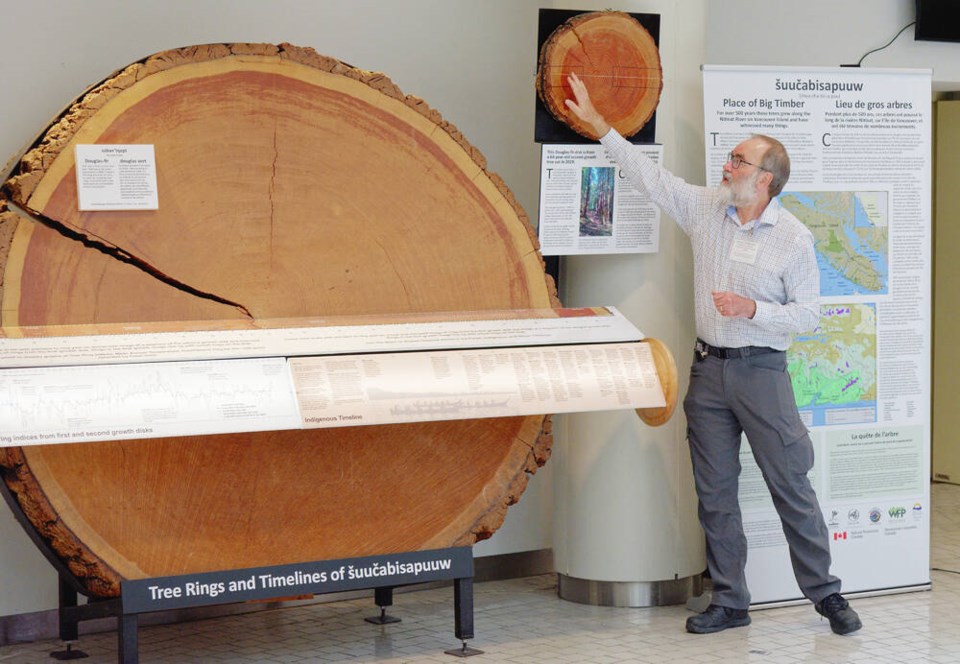About 516 years ago, a Douglas fir seed germinated not far from what would become known as the Nitinat River, west of Cowichan Lake.
The tree that grew from that seedling was felled in 1968 by MacMillan Bloedel foresters, who delivered a 15-centimetre-thick, two-metre-wide cross section of the trunk to the Pacific Forestry Centre.
The tree’s approximately 460-year lifespan covers about 260 years before Europeans first came to the Œ⁄—ª¥´√Ω coast and 200 years of monumental change after that first contact. It coincided with some of the most significant convergences of peoples, cultures and climate in North America’s and British Columbia’s history.
An updated display at the forestry centre on West Burnside Road now chronicles those intersecting timelines.
Instead of the single Euro-focused timeline of the previous display housed in the forestry centre’s lobby for 55 years, the revised exhibit documents local Indigenous and settler historic milestones, the tree’s own significant lifetime events, and changes in climate and atmospheric carbon dioxide for the five centuries recorded in the growth rings in the discs of the first-growth behemoth and a corresponding second-growth tree.
Canadian Forest Service research scientist and soil ecologist Tony Trofymow spearheaded the reconciliation project.
“It started with a reconciliation workshop for federal employees from Vancouver Island and the Lower Mainland,” Trofymow says. “One of the facilitators was from the Justice Institute of Œ⁄—ª¥´√Ω and was of Cree heritage. In her preamble, she pointed out that most people know very little about Indigenous history. ‘For example,’ she said, ‘that big tree cookie out there in the lobby there has this timeline attached to it that doesn’t even mention Indigenous history.’ ”
At the end of the workshop, the facilitators challenged attendees to think about and commit to specific ways that they could further reconciliation in their work.
“My director was there, and he and I talked about it, and I said I would work to update the timeline associated with this Douglas fir disc to include a more appropriate history,” Trofymow says.
Over the five years that followed, Trofymow volunteered many hours outside of his regular research schedule to scour regional archives and local history books for key local forestry and settler events and consult with local historians.
He traced similar big-tree discs to the Alberni Museum and the Vancouver Museum in hopes they all came from the same tree and the combined records would reveal the tree’s original location.
Interviews with museum and archives curators and both current and retired foresters narrowed the search for the big tree’s origins to what was the Macmillan Bloedel’s Franklin River forestry division, which spanned the traditional territories of the Ditidaht, the Huu-ay-aht and the Pacheedaht First Nations.
That information indicated the nations whose participation in the project was critical and whose history was appropriate to include in the display.
Further sleuthing focused the search for the tree’s stump on an area called šuucabisapuuw, or a place of big timber, in the Nitinat Valley, west of Lake Cowichan.
Of course, history didn’t end when the big tree came down. To extend the timeline to the present, a disc from a second-growth Douglas-fir tree from the same area was incorporated into the display. Its tree rings continue the converging history from the time of the big tree’s harvest to 2020.
Three concurrent historical timelines now provide context for the two tree discs.
The settler timeline begins with Christopher Columbus’s first voyage to North America, a significant event for all North American Indigenous Peoples and settlers.
The Ditidaht, the Huu-ay-aht and the Pacheedaht Peoples’ deep-time use of forest resources and the germination in about 1508 of the seed that became the big tree lead the forest timeline.
The Indigenous timeline begins with the Nuu-chah-nulth creation story and the three nations’ occupation of the earliest village sites, which are carbon-dated to as far back as 5,230 years ago.
Scientific timelines tracking tree growth, global average temperatures and atmospheric CO2 levels during the past 520 years complement the human side of the story.
They clearly show how temperature, derived proxies which include tree rings, coral reefs, stalactites and stalagmites, and CO2 levels, based on ice cores from Antarctica and other geological records, have trended upward over the decades.
The new interactive timeline is open to visitors to the Pacific Forestry Centre, at 506 West Burnside Rd.
>>> To comment on this article, write a letter to the editor: [email protected]



